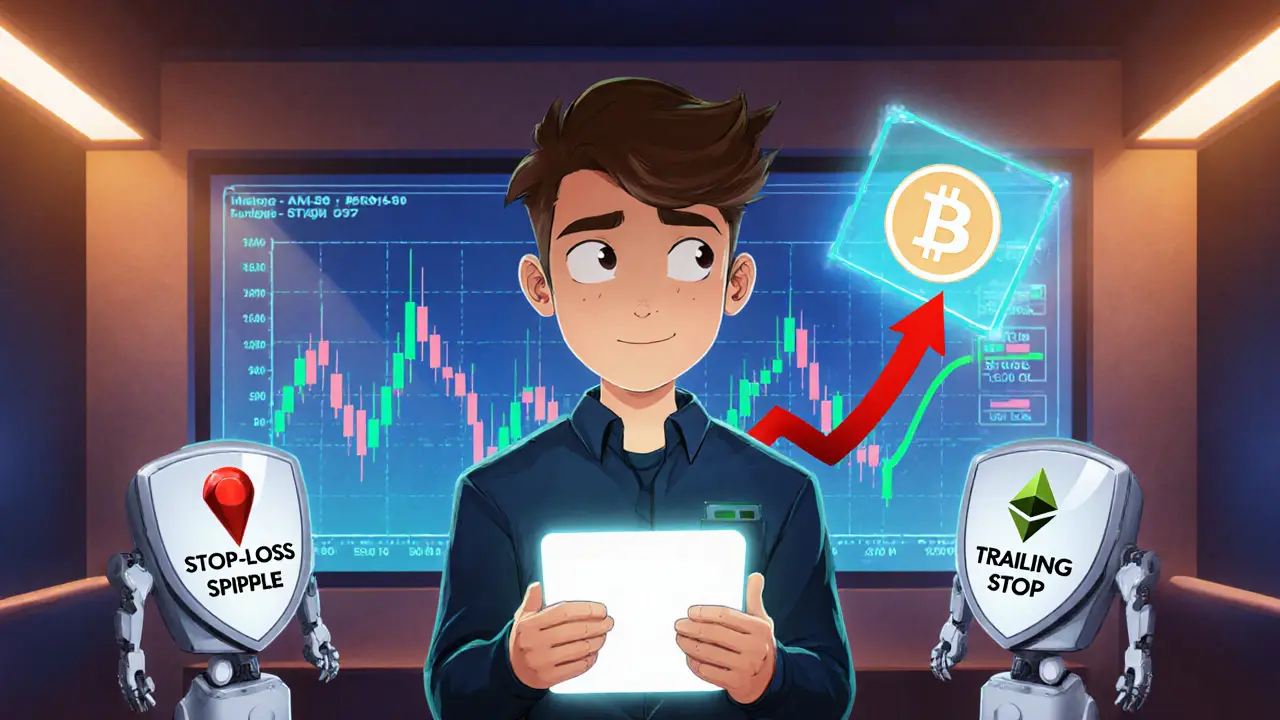Stop-Loss & Trailing Stop Calculator
Stop-Loss vs Trailing Stop Calculator
Calculate optimal exit levels for your crypto position based on entry price, risk tolerance, and volatility. This tool helps you implement the concepts from the article "Stop-Loss vs Trailing Stop: Choosing the Right Crypto Trade Guard".
Results
Stop-Loss Exit
$0.00
Fixed exit point. Protects against sudden drops below this level.
Trailing Stop Exit
$0.00
Dynamic exit that adjusts as price moves in your favor.
Risk vs Reward Comparison
Important Notes
For volatile assets, set stop-loss at least 2-3x your asset's typical daily swing to avoid premature exits. Always test your strategy in a paper trading account before live deployment.
When you’re juggling crypto positions, the biggest fear is a sudden price plunge wiping out your upside. Two tools most traders rely on are the stop-loss and the trailing stop. Both try to shield your capital, but they work in opposite ways. This guide walks through what each order does, when it shines, and how to set them up on modern exchanges.
What is a stop‑loss order?
Stop-Loss Order is a fixed instruction to sell a security once its price reaches a predetermined level below the current market price. The moment the price hits that trigger, the order flips into a market sell and you exit at the best available price. In crypto, you might set a stop‑loss at 15% below the entry price to protect against a sharp downtrend.
- Simple to place on any exchange.
- Works even if the market gaps - you’ll still get the next available price.
- Provides clear emotional comfort; you know exactly where you’ll get out.
How does a trailing stop work?
Trailing Stop Order is a dynamic sell order that moves upward (for a long position) as the market price rises, staying a set distance or percentage behind the highest price reached. If the price reverses by that distance, the order triggers. For example, you buy Bitcoin at $30,000 and set a 5% trailing stop. If Bitcoin climbs to $35,000, the stop price rides up to $33,250. Should the price slip back to that level, you’re out - but you’ve let the trade run as far as it wanted.
- No need to manually adjust the stop as the trade profits.
- Locks in gains while still giving the market room to move.
- Can be set in dollars or percentages, depending on the exchange.

Stop‑loss vs trailing stop: pros and cons
Both orders solve the same problem - limiting loss - but they differ in how they treat profit. Below is a quick side‑by‑side look.
| Aspect | Stop‑Loss | Trailing Stop |
|---|---|---|
| Trigger type | Fixed price level | Dynamic level that follows price |
| Profit handling | Does not protect gains | Rides up with market, locks profit |
| Complexity | Very simple, works on any platform | Needs real‑time price monitoring, not on every exchange |
| Best market condition | Highly volatile or choppy markets | Clear trends with sustained direction |
| Emotional impact | Clear exit point reduces stress | Can cause anxiety if triggered on normal pull‑backs |
Setting up these orders on a crypto exchange
Almost all major Trading Platform software where you buy, sell, and manage cryptocurrency assets support basic stop‑losses. Here’s a quick checklist:
- Open the order ticket for your chosen pair (e.g., ETH/USD).
- Select “Stop‑Loss” from the order‑type dropdown.
- Enter the stop price (either as a $ amount or % below entry).
- Confirm and watch the order appear in your open orders list.
Trailing stops are a bit more niche. Some centralized exchanges like Binance and Kraken have built‑in trailing‑stop functionality; others require you to use a third‑party bot or the exchange’s API.
- If the platform offers “Trailing Stop”, choose it and set the distance (e.g., 4%).
- For platforms without native support, you can write a simple Algorithmic Trading script that watches price and sends a market order when the trailing condition is met script using the exchange’s REST or WebSocket API.
- Test the script on a small position first - market data can be noisy.
Common pitfalls and how to avoid them
Both order types have traps that can bite inexperienced traders.
- Setting the stop too tight. In a volatile crypto market, a 2% stop might get whacked by normal price swings, kicking you out before the trend resumes.
- Ignoring slippage. When the trigger fires, the order becomes a market sell. In a thin order‑book, you could get a price far worse than expected. Using limit orders on high‑liquidity pairs helps.
- Relying on trailing stops in a sideways market. The “ratchet” can repeatedly reset and then snap off, leaving you with a small loss after several premature exits.
- Not accounting for exchange fees. Fees eat into the profit you’re trying to protect, especially on low‑margin trades.
A good rule of thumb is to base your stop distance on the asset’s average true range (ATR) over the past 14 days. That gives a volatility‑adjusted buffer.

Combining both for smarter risk management
Many professional desks treat stop‑loss and trailing stop as complementary tools. Here’s a simple two‑stage approach you can copy:
- Stage 1 - Baseline protection. Set a stop‑loss at 10% below entry. This caps the worst‑case loss.
- Stage 2 - Profit lock‑in. Once the trade is 15% in the green, replace the stop‑loss with a 5% trailing stop. The trade now has a floor and a moving ceiling.
This hybrid method protects you from sudden crashes while still letting you ride strong trends.
Looking ahead: DeFi and smart order routing
Decentralized finance (DeFi Protocol blockchain‑based platforms that provide automated financial services without a central intermediary) is experimenting with on‑chain stop orders. Projects like dYdX and OpenSea are adding “oracle‑driven” stop‑losses that trigger when price feeds cross a threshold. However, latency and gas costs still make traditional exchange stops more reliable for most traders.
On the flip side, smart order routing algorithms are now optimizing where to send stop and trailing orders across multiple venues, reducing slippage and improving execution quality. As these tools mature, you’ll see fewer surprises when a stop hits.
Frequently Asked Questions
Can I use a trailing stop on a short position?
Yes. For a short, the trailing stop moves down instead of up, staying a set distance above the lowest price reached. It protects profits if the market reverses upward.
Do all crypto exchanges support trailing stops?
No. Only larger exchanges like Binance, Kraken, and Bitfinex have native trailing‑stop options. Smaller platforms may require a bot or API script.
What’s the biggest difference between a stop‑loss and a stop‑limit?
A stop‑loss becomes a market order when triggered, guaranteeing execution but not price. A stop‑limit becomes a limit order, which may not fill if the market moves away from your limit price.
How do I decide the trailing‑stop distance?
Start with a percentage that’s larger than the asset’s typical intraday swing, often 3‑7% for major cryptos. Adjust based on volatility metrics like ATR.
Will a stop trigger during a flash crash?
In most cases, yes - the order will execute at the best available price, which may be far from the trigger level during a flash event. Some exchanges offer “stop‑loss limit” to mitigate extreme slippage, but it carries the risk of not filling.




19 Comments
Matthew Homewood
When we think about risk management, the first thing that comes to mind is the illusion of control. A stop‑loss feels like a safety net, but its true power lies in the discipline it enforces. By setting a fixed exit, you remove the emotional tug‑of‑war that comes when the market jittery. The same logic applies to trailing stops – they let profit breathe while still keeping a guardrail. In the end, the choice is less about the tool and more about the mindset.
Bruce Safford
Look, the truth about crypto exchanges is that they’re not the neutral playground they pretend to be. Most of them have hidden algorithms that nudge stop‑loss orders just enough to fill their own liquidity pools. If you set a 10% stop‑loss, the system can slip the execution price an extra 2‑3% during a flash crash, effectively stealing your buffer. This isn’t a conspiracy theory whispered in dark forums but a pattern you can see in the order‑book data if you bother to dig. The trailing‑stop feature is even more suspect because it relies on real‑time price feeds that can be delayed by a few seconds – enough for the market makers to pounce. I’ve seen charts where the price stutters, the trailing stop “moves” down, and the next tick snaps you out at a loss that was never part of your plan. Some devs even embed “soft‑kill” switches that turn off stop‑orders during high volatility periods, claiming it’s for “system stability”. That’s just a fancy way of saying “we can wipe out retail positions when it hurts us”. The math shows that for a volatile asset with an average true range of 5%, a static stop‑loss set at 2% is statistically doomed. You’ll get stopped out on normal noise at least three times a week. Yet the “experts” on YouTube keep preaching a 1‑2% stop as the holy grail. It’s a narrative designed to keep you in a perpetual state of fear, so you keep moving your position size down and stay dependent on the platform. If you want real protection, you need to look at on‑chain stop‑order protocols that settle via smart contracts, not via the exchange’s black box. Even those have latency, but at least the execution rules are transparent. Bottom line: stop‑losses and trailing stops are only as good as the honesty of the venue you trust, and most of them are not as honest as they claim.
Jordan Collins
The article does a solid job of outlining the mechanical differences between a fixed stop‑loss and a trailing stop. It correctly points out that the former offers a clear exit point while the latter allows gains to run. From a risk‑adjusted perspective, combining both can improve the Sharpe ratio of a portfolio. The examples using ATR as a volatility gauge are especially useful for traders who rely on quantitative metrics. Overall, the guide provides a practical framework for implementing these orders on most major exchanges.
Andrew Mc Adam
Glad you liked the breakdown – let me add a couple of practical tips that many newbies overlook. First, always double‑check the precision of the price you input; a misplaced decimal can turn a 5% stop into a 50% nightmare. Second, on exchanges that support both, set your initial stop‑loss a bit wider than the ATR suggestion, then tighten it as the trade matures. Third, watch the order‑book depth – a thin market can cause your stop to slip several ticks away from the trigger. Finally, consider using a stop‑limit rather than a pure market stop if you’re trading low‑liquidity pairs; it gives you some control over the execution price, albeit with the risk of not filling. These small adjustments can save you from an unexpected liquidation and keep your strategy intact.
Shrey Mishra
One of the most common pitfalls is treating a stop‑loss as a guaranteed price. In highly volatile markets, especially during a flash crash, the executed price can deviate significantly from the trigger level. This can erode the very protection you intended to provide. It’s essential to incorporate slippage assumptions into your risk calculations, particularly for assets with thin order books. By accounting for these factors, you can set more realistic stop distances that survive the market’s wild swings.
Tayla Williams
It is morally indefensible to expose uninformed investors to such reckless stop‑loss settings without proper education. The duty of an exchange or a seasoned trader is to promote responsible risk management, not to profit from others’ naïveté. Ignoring the ethical implications of inadequate safeguards contributes to a culture of speculation over stewardship. Therefore, any platform that fails to enforce minimum stop‑loss standards should be held accountable.
Brian Elliot
Appreciate the thorough overview; the two‑stage approach resonates well with my own trading routine.
Marques Validus
Yo dude trailing stops are like the hype train you never want to miss they keep the gains rolling and the stop‑loss just sits there like a wall of fear you know what i mean the market’s a beast and you gotta ride it not choke on every dip
Mitch Graci
Wow, that actually makes sense!!! :)
Lesley DeBow
Consider the paradox of control: we set stops to surrender control, yet we cling to the illusion that we can dictate market destiny. By acknowledging this tension, traders can approach risk management with humility rather than hubris.
DeAnna Greenhaw
While the exposition is commendable, it suffers from an undue simplification of the stochastic nature of crypto price movements. A nuanced discourse would incorporate the ramifications of non‑Gaussian tails and the impact of algorithmic liquidity providers. In its current form, the piece borders on reductionist pedagogy, suitable perhaps for novices but insufficient for the discerning practitioner.
Cynthia Chiang
Great points! If you’re experimenting with stops, try back‑testing them on a paper‑trading account first. This lets you see how often you’d get stopped out in different market regimes without risking real capital.
Ben Johnson
Funny how many traders think a trailing stop is a magical safety net, when in reality it’s just another parameter you have to tune. If you set it too tight, you’ll get whacked on every little wobble; too loose and you might as well have no stop at all.
Della Amalya
Your hybrid method of a baseline stop‑loss followed by a trailing stop is a solid compromise. It gives the trade a safety floor while still allowing upside capture once the market shows momentum.
Kim Evans
Just a heads‑up: remember to factor in exchange fees when you calculate your trailing‑stop distance. Even a 0.1% fee can eat into the profit you’re trying to protect, especially on lower‑margin trades. 😊
Steve Cabe
Statistically, setting a stop‑loss at 1.5 times the 14‑day ATR reduces premature exits by approximately 22% while maintaining acceptable downside risk.
shirley morales
It is an undeniable duty for every trader to uphold the highest standards of prudence and integrity in risk management
Mandy Hawks
The interplay between certainty and uncertainty reminds us that every stop is a philosophical choice about how much of the future we are willing to surrender.
Millsaps Crista
Keep testing and refining your stop strategy – the market will reward consistency and discipline over reckless bravado.